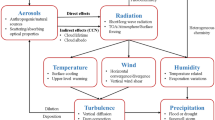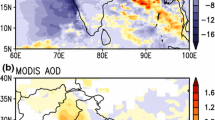Abstract
This commentary is based on a series of recent lectures on aerosol-monsoon interactions I gave at the Beijing Normal University in August 2015. A main theme of the lectures is on a new paradigm of “An Aerosol-Monsoon-Climate-System”, which posits that aerosol, like rainfall, cloud, and wind, is an integral component of the monsoon climate system, influencing monsoon weather and climate on all timescales. Here, salient issues discussed in my lectures and my personal perspective regarding interactions between atmospheric dynamics and aerosols from both natural and anthropogenic sources are summarized. My hope is that under this new paradigm, we can break down traditional disciplinary barriers, advance a deeper understanding of weather and climate in monsoon regions, as well as entrain a new generation of geoscientists to strive for a sustainable future for one of the most complex and challenging human-natural climate sub-system of the earth.
Similar content being viewed by others
References
Carslaw, K. S., L. A. Lee, C. L. Reddington, et al., 2014: Large contribution of natural aerosols to uncertainty in indirect forcing. Nature, 1, 67–71, doi: 10.1038/nature12674.
Chang, C. P., and T. N. Krishnamurti, 1987: Monsoon Meteorology (Oxford Monographs on Geology and Geophyics, No. 7). Oxford University Press, Oxford, 542 pp.
Dai, A. G., 2011: Drought under global warming: A review. Wiley Interdisciplinary Reviews: Climate Change, 1, 45–65.
D’Errico, M., C. Cagnazzo, P. G. Gogli, et al., 2015: Indian monsoon and the elevated-heatpump mechanism in a coupled aerosol-climate model. J. Geophys. Res., 1, 8712–8723, doi: 10.1002/2015JD023346.
Ding, Y. H., 1994: Monsoons over China. Springer, New York, 419 pp.
Ding Yihui, 2015: On the study of the unprecedented heavy rainfall in Henan Province during 4–8 August 1975: Review and assessment. Acta Meteor. Sinica, 1, 411–424, doi: 10.11676/qxxb2015.067. (in Chinese)
Evan, A. T., J. P. Kossin, C. E. Chung, et al., 2011: Arabian Sea tropical cyclones intensified by emissions of black carbon and other aerosols. Nature, 1, 94–97.
Fan, J. W., L. R. Leung, D. Rosenfeld, et al., 2013: Microphysical effects determine macrophysical response for aerosol impacts on deep convective clouds. Proc. Natl. Acad. Sci. U. S. A., 110, E4581–E4590, doi: 10.1073/pnas.1316830110.
Fan, J. W., D. Rosenfeld, Y. Yang, et al., 2015: Substantial contribution of anthropogenic air pollution to catastrophic floods in Southwest China. Geophys. Res. Lett., 1, 6066–6075, doi: 10.1002/2015GL064479.
Fu, C. B., 2003: Potential impacts of human-induced land cover change on East Asian monsoon. Global Planet. Change, 1, 219–229.
Goswami, B. N., V. Venugopal, D. Sengupta, et al., 2006: Increasing trend of extreme rain events over India in a warming environment. Science, 1, 1442–1445, doi: 10.1126/science.1132027.
Halley, E., 1686: A historical account of the trade winds and monsoons observable in the seas between and near the tropics with an attempt to assign the physical cause of the said winds. Phil. Trans. R. Soc. Lond, 1, 153–168.
Hazra, A., B. N. Goswarmi, and J. P. Chen, 2013: Role of interactions between aerosol radiative effect, dynamics and cloud microphysics on transition of monsoon intraseasonal oscillations. J. Atmos. Sci., 1, 2073–2087, doi: 10.1175/JAS-D-12-0179.1.
Kim, M.-K., W. K.-M. Lau, K.-M. Kim, et al., 2015: Amplification of ENSO effects on Indian summer monsoon by absorbing aerosols. Climate Dyn., 1–15, doi: 10.1007/s00382-015-2722-y.
Lau, K.-M., and M.-T. Li, 1984: The monsoon of East Asia and its global associations—A survey. Bull. Amer. Meteor. Soc., 1, 114–125.
Lau, K.-M., and K.-M. Kim, 2006: Observational relationships between aerosol and Asian monsoon rainfall, and circulation. Geophys. Res. Lett., 33, L21810, doi: 10.1029/2006GL027546.
Lau, K.-M., M.-K. Kim, and K.-M. Kim, 2006: Asian summer monsoon anomalies induced by aerosol direct forcing: The role of the Tibetan Plateau. Climate Dyn., 1, 855–864, doi: 10.1007/s00382-006- 0114-z.
Lau, K.-M, S. C. Tsay, C. Hsu, et al., 2008: The joint aerosol-monsoon experiment: A new challenge for monsoon climate research. Bull. Amer. Meteor. Soc., 1, 369–383, doi: 10.1175/BAMS-89-3-369.
Lau, K.-M., K.-M. Kim, Y. C. Sud et al., 2009a: A GCM study of the response of the atmospheric water cycle of West Africa and the Atlantic to Saharan dust radiative forcing. Ann. Geophys., 1, 4023–4037, doi: 10.51941/angeo-27-4023-2009.
Lau, K.-M., K.-M. Kim, C. N. Hsu, et al., 2009b: Possible influences of air pollution, dust- and sandstorms on the Indian monsoon. WMO Bulletin, 1, 22–30.
Lau, K.-M., and D. E. Waliser, 2012: Intraseasonal Variability in the Atmosphere-Ocean Climate System. 2nd ed. Springer Berlin Heidelberg, 613 pp, doi: 10.1007/978-3-642-13914-7.
Lau, K.-M., 2014: Atmospheric science: Desert dust and monsoon rain. Nat. Geosci., 1, 255–256, doi: 10.1038/ngeo2115.
Lau, K.-M., and K.-M. Kim, 2015a: Impacts of absorbing aerosols on the Asian monsoon: An interim assessment. World Science Series on Asian-Pacific Weather and Climate, Vol. 6, Climate Change: Multidecadal and Beyond, Chang, C. P., M. Ghil, M. Latif, et al., Eds., World Scientific Publishing, 376 pp.
Lau, K.-M., and K.-M. Kim, 2015b: Hadley Circulation changes and increasing global dryness due to CO2 warming from CMIP5 model projections. Proc. Natl. Acad. Sci., 1, 3630–3635, doi: 10.1073/pnas.1418682112.
Li, Z. Q., K.-H. Lee, Y. S. Wang, et al., 2010: First observation-based estimates of cloud-free aerosol radiative forcing across China. J. Geophys. Res., 115, D00K18, doi: 10.1029/2009JD013306.
Li, Z. Q., F. Niu, J. W. Fan, et al., 2011: Long-term impacts of aerosols on the vertical development of clouds and precipitation. Nat. Geosci., 1, 888–894, doi: 10.1038/ngeo1313.
Manoj, M. G., P. C. S. Devara, P. D. Safai, et al., 2011: Absorbing aerosols facilitate transition of Indian monsoon breaks to active spells. Climate Dyn., 1, 2181–2198, doi:10.1007/s00382-010-0971-3.
Meehl, G. A., J. M. Arblaster, and W. D. Collins, 2008: Effects of black carbon aerosols on the Indian monsoon. J. Climate, 1, 2869–2882, doi: 10.1175/2007JCLI1777.1.
Menon, S., J. Hansen, L. Nazarenko, et al., 2002: Climate effects of black carbon aerosols in China and India. Science, 1, 2250–2253, doi: 10.1126/science. 1075159.
Niu, F., Z. Q. Li, C. Li, et al., 2010: Increase of wintertime fog in China: Potential impacts of weakening of the eastern Asian monsoon circulation and increasing aerosol loading. J. Geophys. Res., 115, D00K20, doi: 10.1029/2009JD013484.
Ramanathan, V., P. J. Crutzen, J. T. Kiehl, et al., 2001: Aerosols, climate, and the hydrological cycle. Science, 1, 2119–2124, doi: 10.1126/science.1064034.
Ramanathan, V., and G. Carmichael, 2008: Global and regional climate changes due to black carbon. Nat. Geosci., 1, 221–227, doi: 10.1038/ngeo156.
Ramage, C., 1971: Monsoon Meteorology. Int. Geophys. Series, 15. Academic Press, San Diego, California, 296 pp.
Rasmusson, E. M., and T. H. Carpenter, 1983: The relationship between eastern equatorial Pacific sea surface temperatures and rainfall over India and Sri Lanka. Mon. Wea. Rev., 1, 517–528.
Rosenfeld, D., U. Lohmann, G. B. Raga, et al., 2008: Flood or drought: How do aerosols affect precipitation? Science, 1, 1309–1313, doi: 10.1126/science. 1160606.
Rosenfeld, D., W. L. Woodley, A. Khain, et al., 2012: Aerosol effects on microstructure and intensity of tropical cyclones. Bull. Amer. Meteor. Soc., 1, 987–1001.
Rosenfeld, D., M. O. Andreae, A. Asmi, et al., 2014: Global observations of aerosol-cloud-precipitationclimate interactions. Rev. Geophys., 1, 750–808, doi: 10.1002/2013RG000441.
Satheesh, S. K., and J. Srinivasan, 2002: Enhanced aerosol loading over Arabian Sea during the premonsoon season: Natural or anthropogenic? Geophys. Res. Lett., 1, 21-1-21-4, doi: 10.1029/ 2002GL015687.
Satheesh S. K., and K. K. Moorthy, 2005: Radiative effects of natural aerosols: A review. Atmos. Environ., 1, 2089–2110, doi: 10.1016/jatmosenv. 2004.12.029.
Vinoj, V., P. J. Rasch, H. L. Wang, et al., 2014: Shortterm modulation of Indian summer monsoon rainfall by West Asian dust. Nat. Geosci., 1, 308–313, doi: 10.1038/NGEO2107.
Wang, B., 2006: The Asian Monsoon. Praxis Publishing Ltd., Chichester, UK, 787 pp.
Wang, B., S. B. Xu, and L. G. Wu, 2012: Intensified Arabian Sea tropical storms. Nature, 489, E1–E2, doi: 10.1038/nature11470.
Wang, C., D. Kim, A. M. L. Ekman, et al., 2009: Impact of anthropogenic aerosols on Indian summer monsoon. Geophys. Res. Lett., 36, L21704, doi: 10.1029/2009GL040114.
Wang, Y. Q., and L. Zhou, 2005: Observed trends in extreme precipitation events in China during 1961–2001 and the associated changes in large-scale circulation. Geophys. Res. Lett., 1, L09707, doi: 10.1029/2005GL022574.
Wang, Y., K.-H. Lee, Y. Lin, et al., 2014: Distinct effects of anthropogenic aerosols on tropical cyclones. Nat. Climate Change, 1, 368–373.
Webster, P. J., V. O. Maga˜na, T. N. Palmer, et al., 1998: Monsoons: Processes, predictability, and the prospects for prediction. J. Geophys. Res., 1, 14451–14510, doi: 10.1029/97JC02719.
Wu, G. X., A. M. Duan, Y. M. Liu, et al., 2014: Recent progress in the study of Tibetan Plateau climate dynamics. Natl. Sci. Rev., doi: 10.1093/nsr/nwu045.
Zhang, H., Z. L. Wang, P. W. Guo, et al., 2009: A modeling study of the effects of direct radiative forcing due to carbonaceous aerosol on the climate in East Asia. Adv. Atmos. Sci., 1, 57–66.
Zhang, H., Z. L. Wang, Z. Z. Wang, et al., 2012: Simulation of direct radiative forcing of aerosols and their effects on East Asian climate using an interactive AGCM-aerosol coupled system. Climate Dyn., 1, 1675–1693, doi: 10.1007/s00382-011-1131-0.
Zhang, R. Y., G. H. Li, J. W. Fan et al., 2007: Intensification of Pacific storm track linked to Asian pollution. Proc. Natl. Acad. Sci. U.S.A., 1, 5295–5299, doi: 10.1073/pnas.0700618104.
Author information
Authors and Affiliations
Corresponding author
Additional information
Supported jointly by the US Department of Energy, Pacific Northwest National Laboratory (4331620), Earth System Science Interdisciplinary Center, University of Maryland, and Department of Atmospheric Sciences, Texas A & M University.
Rights and permissions
About this article
Cite this article
Lau, W.K.M. The aerosol-monsoon climate system of Asia: A new paradigm. J Meteorol Res 30, 1–11 (2016). https://doi.org/10.1007/s13351-015-5999-1
Received:
Accepted:
Published:
Issue Date:
DOI: https://doi.org/10.1007/s13351-015-5999-1




